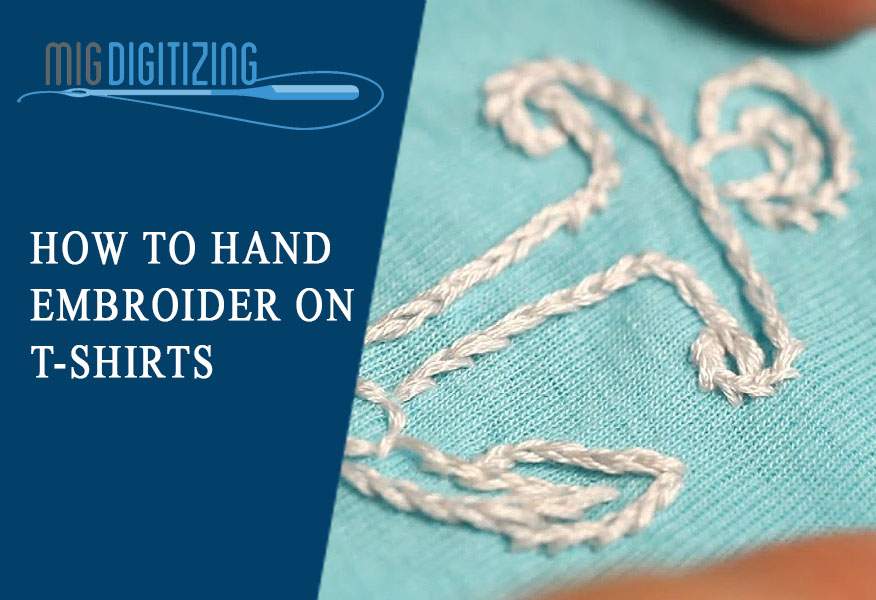
Do you want to make your outfit a little more interesting? Learn how to hand embroider a t-shirt and add uniqueness to your clothing! Because no sewing machine is necessary, this blog is ideal for beginners. If you prepare properly, adding a simple embroidery on a baby onesie, a T-shirt, or another item made of stretchy fabric can be pretty straightforward. When embroidering on a flexible T-shirt fabric, one of the most significant issues is that the design might get distorted if the fabric is stretched or tugged too firmly.
That issue will be resolved with the use of a stabiliser. The embroidered accent on a T-shirt, a baby onesie, or anything else might be a large design or a little and basic design. Hand embroidery on a T-shirt is a great way to make something one-of-a-kind and special.
Stabilizers of various types
With practically all types of embroidery, a stabiliser can be used, although, with garments, it is preferable to use a removable stabiliser rather than one that is made to stay in place. A leave-in stabiliser is one that is designed to stay in place. This will keep the stitching on the back of your hand feeling comfortable and not rough and unpleasant.
Stabilizers for embroidering on stretchy T-shirts and other stretchy materials come in a variety of styles. Some are long-term, while others are very brief. Some stabilisers disintegrate when exposed to water, while others pull away. There's also a stabiliser that uses huge basting stitches to connect to the fabric and another that adheres directly to the cloth. Any of the stabilisers will work for you in general. Finding out which one you favour is a matter of practice.
Any of these stabilisers are designed to keep the cloth from stretching. When the cloth isn't allowed to stretch, the embroidery won't be distorted once the hoop is removed.
Before applying the stabiliser, it's a good idea to trace or transfer your pattern onto the T-shirt or another piece of fabric. However, this will be dependent on the type of stabilising material you use.
Hand Embroidering a T-Shirt Requires the Following Equipment:
Stabilizer
Floss for embroidery
Iron Needle Embroidery Hoop is a round embroidery hoop that is preferred.
Hand Embroidery Instructions for a T-Shirt
Mini stabilisers will be made to be placed on the embroidery's backside. As a result, you'll begin by flipping the T-shirt inside out.
Place the stabiliser in the area where you want to stitch with care.
To secure the stabiliser to the T-shirt, use a needle and thread to make some large basting stitches. Don't worry if the basting stitches go through the area you'll be embroidering; the basting stitches will be removed later.
Turn the T-shirt inside out at this point.
Use the Press and Stick Material to stabilise the fabric
Stabilizers that are pressed and stuck will attach to the surface of your fabric. They can then be applied to the front or back of a T-shirt. A water-soluble stabiliser is included in one variety, which adds to the attraction of packing. That is, you apply them on the surface as if they were stickers. The other type can be pressed onto the clothing and then torn away afterwards.
Because you can print, transfer, or trace the design directly onto the stabiliser, a detachable stabiliser is frequently a good idea.
Without stretching the fabric, hoop it
Make sure the shirt is loose underneath the outer hoop before putting it on. Then, inside the shirt, position the inner hoop under the spot where you'll be stitching. If you notice that you've stretched or distorted the cloth by accident, simply re-hoop it.
T-Shirt stitching instructions
Needles for tapestry or counted cross-stitch work wonderfully. These are the needles that are most likely to pierce the fabric's knit without piercing any further risks. T-shirt embroidery, like any other type of embroidery, requires a good start and finish. This is particularly crucial because you don't want any stitching to come undone when the garment is cleaned. Tying knots on the thread causes the textiles to be pulled and stretched, distorting the design once more. Instead, tie the end with a secure weave to keep your embroidery looking wonderful.
Continue to enhance it, as usual, being cautious not to pull the stitches too tight. The stabiliser will aid, but it should not be your main source of protection.
Stabilizer should be removed
Remove the basting stitches carefully by snipping the thread and gently removing them if you used a stabiliser that you pasted onto the tea.
If you use a rip-away stabiliser, tear the fabric along the edges all the way up to the embroidery, then remove the pieces from the inside of the embroidery pattern. Take extreme caution not to snag your stitches.
If you used a water-soluble stabiliser, carefully clip away the excess stabiliser from the edges before using warm water to embroider. Then, to remove any excess water, flatten the T-shirt between two towels and hang it to dry.



